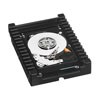- Qualcomm Launches Snapdragon 4 Gen 2 Mobile Platform
- AMD Launches Ryzen PRO 7000 Series Mobile & Desktop Platform
- Intel Launches Sleek Single-Slot Arc Pro A60 Workstation Graphics Card
- NVIDIA Announces Latest Ada Lovelace Additions: GeForce RTX 4060 Ti & RTX 4060
- Maxon Redshift With AMD Radeon GPU Rendering Support Now Available
Western Digital VelociRaptor 600GB

Solid-state may be the future of our storage, but for now, the prices for the latest SSD’s (even value models) is still far too high on the $/GB scale. For those looking for mass storage and still-great speeds, mechanical storage is still on top, and WD’s latest VelociRaptor’s, which utilize SATA 3.0, sit comfortably above all the rest.
Page 7 – Temperatures, Acoustics, Power Consumption
When the time comes to pick out a brand-new hard drive for a PC, most consumers tend to look past everything except the densities. While most enthusiasts care a lot about performance, regular end-consumers usually don’t even know there’s a difference between drives. Well, as we’ve seen throughout all of our tests, there’s a clear difference between drives, even those that have identical rotational speeds. But, aside from these two things, there are a couple more aspects to look at: Temperatures, Acoustics, and Power Consumption.
Arguably, temperatures are the most important factor of the three, as if a drive runs too hot all of the time, then its life span is going to be decreased. Not to mention, it will add unneeded heat to the inside of your PC, causing everything else to run even hotter. Even in a chassis with superb airflow, hard drive heat remains a problem, especially when one is dealing with transfers for a long period of time. Most companies will agree that a hard drive can run up to 50°C and still remain reliable, but if your drive runs hotter than that, it’s time to figure out a solution.
Then there’s the acoustics, and if you’ve ever had a loud-running drive, then this is likely a factor that’s important to you. Although all drives have improved in this regard over the years, it’s still not rare to hear a hard drive doing its thing, especially when the room is quiet. Lastly, there’s power consumption. Admittedly, power consumption tends to be a non-issue for most people, since they draw such a low amount of power compared to CPUs, GPUs and other components, but we include the results for sake of interest.
All three of these tests are conducted at the same time. After the PC is boot up, we allow five minutes to pass while Windows settles down, at which point we monitor the idle wattage, acoustics and temperatures. To stress the drive, we load up our Iometer test and let it do its thing, capturing the highest figures we see for each test. The temperatures are captured with Everest Ultimate Edition 5.3, while our power consumption is captured with a Kill-a-Watt EZ, dedicated to its own socket, with only the PC plugged into it. We capture the drive’s acoustics with a SL-5868P audio meter, with its microphone located a few centimeters above the drive.



At the end of this round we now have the warmest, noisiest and power hungry drive crowned. The tie with the 300GB drive in power consumption was not surprising while I was definitely surprised at the extra heat. None of these factors were anything of concern as heat and power consumption figures are well within reason. Noise is also no real issue unless you keep your PC next to your ear. Once up to speed, I don’t find the VR any louder than most.
Support our efforts! With ad revenue at an all-time low for written websites, we're relying more than ever on reader support to help us continue putting so much effort into this type of content. You can support us by becoming a Patron, or by using our Amazon shopping affiliate links listed through our articles. Thanks for your support!




